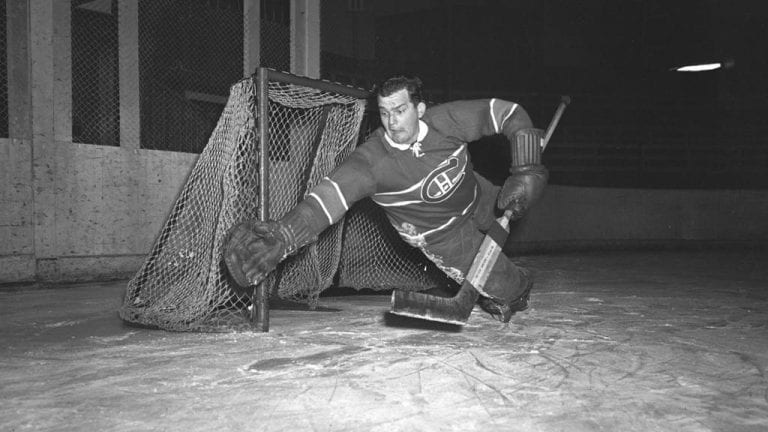

by Cate Racher, Staff Writer/Copy Editor, All Habs Hockey Magazine
Welcome to Habs History! Throughout this series, we’re going to be taking a look at the top seven goalies to ever wear the bleu-blanc-rouge throughout the Habs’ extensive history, according to their number of wins. It will include bios, player stats, and other fun facts about some of our favourite team goalies and how they fit into the team’s history. This week, we’ll be taking a look at Bill Durnan, but before we do that, be sure to check out parts one and two below.
No.7: Michel “Bunny” Larocque
No.6: “Little George” Hainsworth
William “Bill” Ronald Durnan was born on January 22, 1916 in Toronto, Ontario. At nine years old, Bill began to play for his local church hockey league. The coach, Steve Faulkner, noticed very early on that young Bill had a special talent for being able to use his hockey stick in either hand, and encouraged him to further develop this talent. Bill would later attribute his NHL success and netminding prowess to Faulkner’s insistence that he play with both hands, eventually earning him the nickname “Dr. Strange Glove” because he played wearing two gloves rather than a glove and a blocker.

Durnan played for multiple amateur teams within the Maple Leafs development chain in his early teens. Unfortunately, Bill was injured off-ice a few times and Maple Leafs management dropped him.
“…suddenly I wasn’t especially concerned with playing pro hockey at all.”
In conversation with Hal Bock, author of “Save”, Durnan credited this as the reason he was bitter towards professional hockey and why he was reluctant to play in the NHL. “I had been one of those zealous kids who just lived for an NHL career. Suddenly I wasn’t especially concerned with playing pro hockey at all,” said Durnan.
Durnan began working in Northern Ontario’s mining region during the Great Depression. At 20 years of age, he tended goal for the Kirkland Lake Blue Devils where he played until he was 24. During his last year, Durnan lead the team to an Allan Cup victory, sweeping the Calgary Stampeders from the playoffs after just three games.
The Montreal Royals took notice of him and after some convincing from friends in the city, Durnan signed on in Montreal.
Bill’s performance with the Royals, where he maintained a goals-against average (GAA) of about 3.62 during his time with the team, was enough for both Canadiens’ coach Dick Irvin and general manager Tommy Gorman to take notice of the up-and-coming goaltender. When Paul Bibeault left the Habs to join the army, Canadiens upper management agreed that Bill would be the perfect replacement.
At this time, Durnan was only earning about 15 dollars per week playing hockey, softball, and performing other odd jobs. In spite of this, he was still reluctant to sign on with the Canadiens due to his experiences with the Maple Leafs and insisted he was fine with playing amateur hockey because professional games were too stressful. Bill was signed to the team only minutes before the start of the season opener in 1943-’44, where they tied the Boston Bruins 2-2. He went undefeated for his first 14 games, winning 11 games and tying three.
Durnan’s inaugural season with the team saw the Habs lose only five out of the 50 regular season games, and thanks to Bill’s combined efforts with Elmer Lach, Toe Blake, and Maurice Richard, the Canadiens were able to take home the Stanley Cup for the first time in 13 years that season. The 1943-’44 season would also be the first of six Vezina trophy wins for “Dr. Strange Glove.” He would only lose the honour once when it was given to Turk Broda of the Maple Leafs during the 1947-’48 season.

After Toe Blake’s career ended in 1948 due to a broken leg, Durnan was elected as captain of the team. The 6-foot, 190 pound goalie remained captain for the rest of the season and was the last goaltender to sport the “C” until new rules in the NHL forbade goalies from serving as on-ice captains.
It has been suggested that he suffered a nervous breakdown at one point. According to D’Arcy Jenish, a hockey historian, this happened after “being hit in the face by too many pucks, sticks, and errant skate blades…he had been jeered by Montreal’s unforgiving fan base and couldn’t sleep before or after games.” Despite maintaining that he was fine, teammates and fans alike began to notice the stress that Bill was under as he himself admitted that his nerves were building and he was worried about his contributions to the team’s lack of success.
In the midst of the Stanley Cup playoffs in 1950, Bill quietly told coach Dick Irvin that he was done playing professional hockey. He retired abruptly at the age of 34 with a career GAA of 2.36. He was inducted into the Hockey Hall of Fame 14 years after his retirement from the sport and was remembered by his teammates and rivals alike as one of the nicest guys to play hockey with a smile for everyone.
Bill Durnan suffered from both diabetes and kidney failure later in his life. He died on October 31, 1972 at the age of 56 and was buried at the Highland Memory Gardens in Toronto.